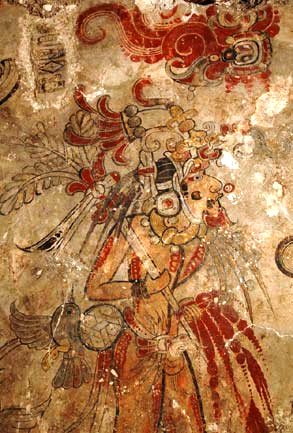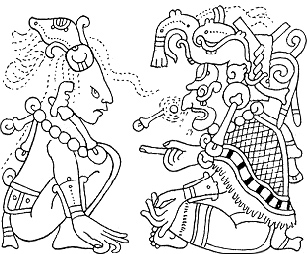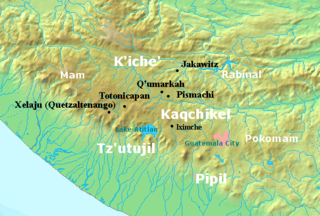
Qʼuqʼumatz was a god of wind and rain of the Postclassic Kʼicheʼ Maya. It was the Feathered Serpent that according to the Popol Vuh created the world and humanity, together with the god Tepeu. It carried the sun across the sky and down into the underworld and acted as a mediator between the various powers in the Maya cosmos. It is considered to be the equivalent of the Aztec god Quetzalcoatl and of Kukulkan, of the Yucatec Maya.
Huracan, often referred to as U Kʼux Kaj, the "Heart of Sky", is a Kʼicheʼ Maya god of wind, storm, fire and one of the creator deities who participated in all three attempts at creating humanity. He also caused the Great Flood after the second generation of humans angered the gods. He supposedly lived in the windy mists above the floodwaters and repeatedly invoked "earth" until land came up from the seas.

Popol Vuh is a text recounting the mythology and history of the Kʼicheʼ people of Guatemala, one of the Maya peoples who also inhabit the Mexican states of Chiapas, Campeche, Yucatan and Quintana Roo, as well as areas of Belize, Honduras and El Salvador.

Zaculeu or Saqulew is a pre-Columbian Maya archaeological site in the highlands of western Guatemala, about 3.7 kilometres (2.3 mi) outside the modern city of Huehuetenango. Occupation at the site dates to the Early Classic period (AD 250–600) of Mesoamerican history. Zaculeu was the capital of the Postclassic Mam kingdom, and was conquered by the Kʼicheʼ Kingdom of Qʼumarkaj. It displays a mixture of Mam and Kʼicheʼ style architecture.
Kʼicheʼ are Indigenous peoples of the Americas and are one of the Maya peoples. The eponymous Kʼicheʼ language is a Mesoamerican language in the Mayan language family. The highland Kʼicheʼ states in the pre-Columbian era are associated with the ancient Maya civilization, and reached the peak of their power and influence during the Mayan Postclassic period.

Tecun Uman was one of the last rulers of the K'iche' Maya people, in the Highlands of what is now Guatemala. According to the Kaqchikel annals, he was slain by Spanish conquistador Pedro de Alvarado while waging battle against the Spanish and their allies on the approach to Quetzaltenango on 12 February 1524. Tecun Uman was declared Guatemala's official national hero on March 22, 1960, and is commemorated on February 20, the popular anniversary of his death. Tecun Uman has inspired a wide variety of activities ranging from the production of statues and poetry to the retelling of the legend in the form of folkloric dances to prayers. Despite this, Tecun Uman's existence is not well documented, and it has proven to be difficult to separate the man from the legend.

Qʼumarkaj is an archaeological site in the southwest of the El Quiché department of Guatemala. Qʼumarkaj is also known as Utatlán, the Nahuatl translation of the city's name. The name comes from Kʼicheʼ Qʼumarkah "Place of old reeds".

San Bartolo is a small pre-Columbian Maya archaeological site located in the Department of Petén in northern Guatemala, northeast of Tikal and roughly fifty miles from the nearest settlement. San Bartolo's fame derives from its splendid Late-Preclassic mural paintings still heavily influenced by Olmec tradition and from examples of early and as yet undecipherable Maya script.

The traditional Maya or Mayan religion of the extant Maya peoples of Guatemala, Belize, western Honduras, and the Tabasco, Chiapas, Quintana Roo, Campeche and Yucatán states of Mexico is part of the wider frame of Mesoamerican religion. As is the case with many other contemporary Mesoamerican religions, it results from centuries of symbiosis with Roman Catholicism. When its pre-Hispanic antecedents are taken into account, however, traditional Maya religion has already existed for more than two and a half millennia as a recognizably distinct phenomenon. Before the advent of Christianity, it was spread over many indigenous kingdoms, all with their own local traditions. Today, it coexists and interacts with pan-Mayan syncretism, the 're-invention of tradition' by the Pan-Maya movement, and Christianity in its various denominations.

Iximcheʼ is a Pre-Columbian Mesoamerican archaeological site in the western highlands of Guatemala. Iximche was the capital of the Late Postclassic Kaqchikel Maya kingdom from 1470 until its abandonment in 1524. The architecture of the site included a number of pyramid-temples, palaces and two Mesoamerican ballcourts. Excavators uncovered the poorly preserved remains of painted murals on some of the buildings and ample evidence of human sacrifice. The ruins of Iximche were declared a Guatemalan National Monument in the 1960s. The site has a small museum displaying a number of pieces found there, including sculptures and ceramics. It is open daily.

The Kʼicheʼ kingdom of Qʼumarkaj was a state in the highlands of modern-day Guatemala which was founded by the Kʼicheʼ (Quiché) Maya in the thirteenth century, and which expanded through the fifteenth century until it was conquered by Spanish and Nahua forces led by Pedro de Alvarado in 1524.

The Chajoma were a Kaqchikel-speaking Maya people of the Late Postclassic period, with a large kingdom in the highlands of Guatemala. According to the indigenous chronicles of the K'iche' and the Kaqchikel, there were three principal Postclassic highland kingdoms; the K'iche', the Kaqchikel and the Chajoma. In the Annals of the Cakchiquels the Chajoma of Jilotepeque were always referred to as the akajal vinak, in the Popul Vuh these can probably be identified with the akul vinak. Both akajal vinak and akul vinak mean "the bee people" or "the hive people".

Chitinamit is an archeological site of the Maya civilization in the highlands of Guatemala. It has been identified as Jakawitz, the first capital of the K'iche' Maya. The site is located in the El Quiché department, in the municipality of Uspantán. Chitinamit dates from the Early Classic through to the Late Postclassic periods and covers approximately 2 hectares (220,000 sq ft), making it the largest site in its region.
Jacawitz was a mountain god of the Postclassic Kʼicheʼ Maya of highland Guatemala. He was the patron of the Ajaw Kʼicheʼ lineage and was a companion of the sun god Tohil. It is likely that he received human sacrifice. The word jacawitz means "mountain" in the lowland Maya language, and the word qʼaqʼawitz of the highland Maya means "fire mountain", which suggests that Jacawitz was mainly a fire deity, much like Tohil. In the Mam language, the similar word xqʼaqwitz means "yellow wasp" and the wasp was an important symbol of the deity and its associated lineage. In the Cholan languages, jacawitz means "first mountain", linking the god with the first mountain of creation.

Awilix was a goddess of the Postclassic Kʼicheʼ Maya, who had a large kingdom in the highlands of Guatemala. She was the patron deity of the Nijaʼibʼ noble lineage at the Kʼicheʼ capital Qʼumarkaj, with a large temple in the city. Awilix was a Moon goddess and a goddess of night, although some studies refer to the deity as male. Awilix was probably derived from the Classic period lowland Maya moon goddess or from Cʼabawil Ix, the Moon goddess of the Chontal Maya.

During the pre-Columbian era, human sacrifice in Maya culture was the ritual offering of nourishment to the gods and goddesses. Blood was viewed as a potent source of nourishment for the Maya deities, and the sacrifice of a living creature was a powerful blood offering. By extension, the sacrifice of human life was the ultimate offering of blood to the gods, and the most important Maya rituals culminated in human sacrifice. Generally, only high-status prisoners of war were sacrificed, and lower status captives were used for labor.
The Título de Totonicapán, sometimes referred to as the Título de los Señores de Totonicapán is the name given to a Kʼicheʼ language document written around 1554 in Guatemala. The Título de Totonicapán is one of the two most important surviving colonial period Kʼicheʼ language documents, together with the Popol Vuh. The document contains history and legend of the Kʼicheʼ people from their mythical origins down to the reign of their most powerful king, Kʼiqʼab.

Chutixtiox is an archaeological site of the ancient Maya civilization near Sacapulas, in the Quiché department of modern Guatemala. The site was excavated during the 20th century by A. Ledyard Smith. Ceramic evidence excavated at the site suggests a close relationship with the K'iche' capital of Q'umarkaj. Chutixtiox may have been a settlement in a polity that included the nearby sites of Chutinamit and Xolpacol.
The Título Cʼoyoi is an important early colonial Kʼiche document documenting the mythical origins of the Kʼicheʼ people and their history up to the Spanish conquest. It describes Kʼicheʼ preparations for battle against the Spanish, and the death of the Kʼicheʼ hero Tecun Uman. The document was written in Qʼumarkaj, the Kʼicheʼ capital city, by the Cʼoyoi Sakcorowach lineage, which belonged to the Quejnay branch of the Kʼicheʼ, and who held territory just to the east of Quetzaltenango, now in Guatemala. The document was largely written by Juan de Penonias de Putanza, who claimed to be the relative of a Cʼoyoi nobleman who was killed during the Spanish conquest. It was composed with the assistance of the Kʼicheʼ officialdom at Qʼumarkaj, and portions of the text reflect the official version of Kʼicheʼ history as produced in the capital. An illustration in the document shows that the Maya nobility of Quetzaltenango adopted the double-headed Habsburg Eagle as their family crest.















